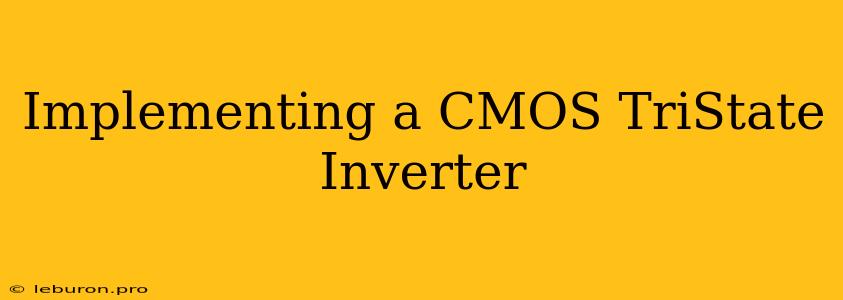Implementing a CMOS TriState Inverter is a fundamental technique in digital circuit design. It provides an efficient way to control the flow of data within a system, acting as a switch that can either pass or block the signal based on a control input. This article delves into the design, operation, and applications of CMOS TriState inverters, exploring their unique characteristics and advantages.
Understanding TriState Operation
The term "TriState" refers to the three possible states a circuit can exhibit: high (logic 1), low (logic 0), and high-impedance (Z). A TriState Inverter is a special type of inverter circuit that incorporates a control input alongside its standard input and output. The control input determines whether the inverter operates normally, passing the signal through, or enters the high-impedance state, effectively blocking the signal. This ability to switch between active and passive states makes TriState inverters invaluable in various applications, particularly when managing data flow in complex systems.
The CMOS Implementation
A CMOS (Complementary Metal-Oxide Semiconductor) TriState inverter is constructed using a combination of NMOS and PMOS transistors. The core of the circuit is a standard CMOS inverter, comprising a PMOS transistor connected in series with an NMOS transistor. This inverter is responsible for inverting the input signal when the control input is enabled. However, the key to TriState functionality lies in an additional PMOS transistor connected in series with the output. This PMOS transistor, controlled by the control input, acts as a gate, enabling or disabling the flow of current to the output.
Working Principle
-
Enabled State: When the control input is high (logic 1), the additional PMOS transistor is turned ON, allowing the signal from the inverter to pass through to the output. The circuit functions as a normal inverter, with the output value complementing the input signal.
-
Disabled State: When the control input is low (logic 0), the additional PMOS transistor is turned OFF, effectively blocking the current flow to the output. The output is then in a high-impedance state (Z), neither high nor low, and essentially disconnected from the circuit.
Benefits of CMOS TriState Inverters
-
Data Multiplexing: TriState inverters enable the multiplexing of data signals. Multiple data sources can be connected to a single output, and the control input selects which source is actively transmitted.
-
Bus Sharing: TriState inverters are essential for sharing data buses. Multiple devices can access the same bus, but only one device can write data to the bus at a time, with the control input of each device enabling or disabling its write operation.
-
Memory Access: TriState inverters play a crucial role in memory systems, where they allow multiple memory locations to share the same bus. By selectively enabling the TriState inverters associated with specific locations, the memory controller can read or write data to individual locations.
-
Logic Optimization: TriState inverters can simplify complex logic circuits. By using a TriState inverter to selectively enable or disable a portion of the logic, the circuit can be optimized for performance and power consumption.
Applications of CMOS TriState Inverters
1. Memory Systems: TriState inverters are used extensively in memory systems, particularly in DRAM (Dynamic Random Access Memory) chips, where they facilitate multiplexed access to memory locations.
2. Microprocessors and Microcontrollers: TriState inverters are found in microprocessor and microcontroller architectures to control data flow between different functional blocks.
3. Peripheral Devices: TriState inverters are used in peripheral devices like disk controllers and network interfaces to manage data transfers.
4. Logic Circuits: TriState inverters simplify complex logic circuits by allowing for efficient control of data flow.
5. Bus Systems: TriState inverters are vital for implementing bus systems, where multiple devices need to share access to a common data path.
Design Considerations
-
Control Signal: The control signal must be designed to reliably switch the PMOS transistor between ON and OFF states.
-
Voltage Levels: The voltage levels used for the control input and the output signal must be compatible with the rest of the circuit.
-
Current Handling: The PMOS transistor must be capable of handling the expected current load during normal operation.
-
Propagation Delay: The delay introduced by the TriState inverter must be considered in the design of timing-critical systems.
Conclusion
Implementing a CMOS TriState Inverter is a powerful technique that unlocks flexibility and efficiency in digital circuit design. Their ability to control data flow, multiplex signals, and simplify logic circuitry makes them indispensable in various electronic systems. Understanding the principles of operation, benefits, and applications of TriState inverters is essential for anyone involved in digital circuit design or the analysis of complex electronic systems.
